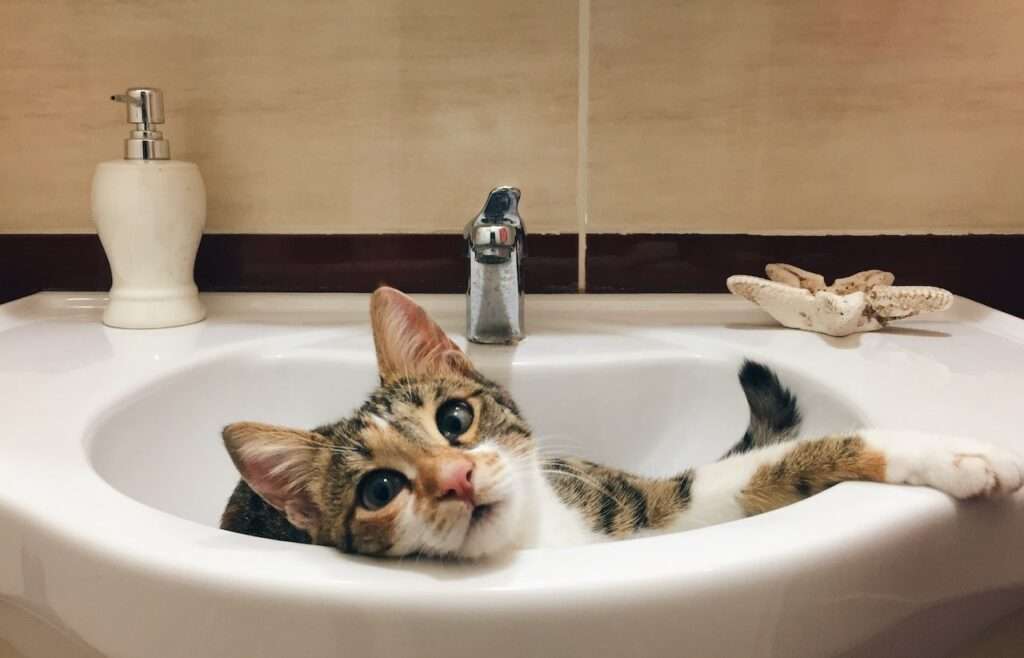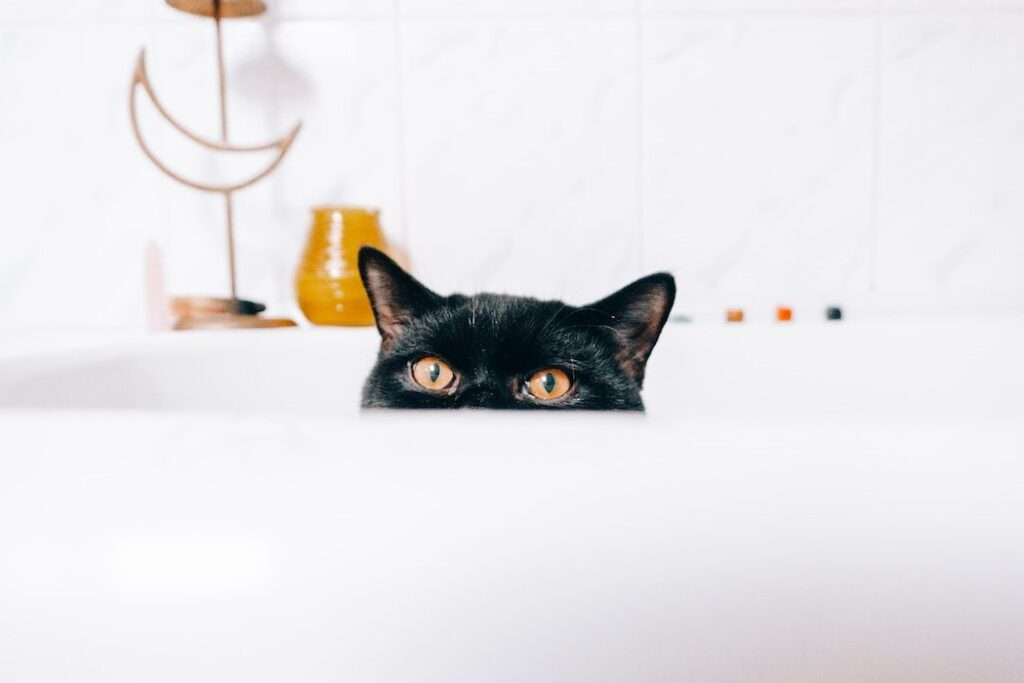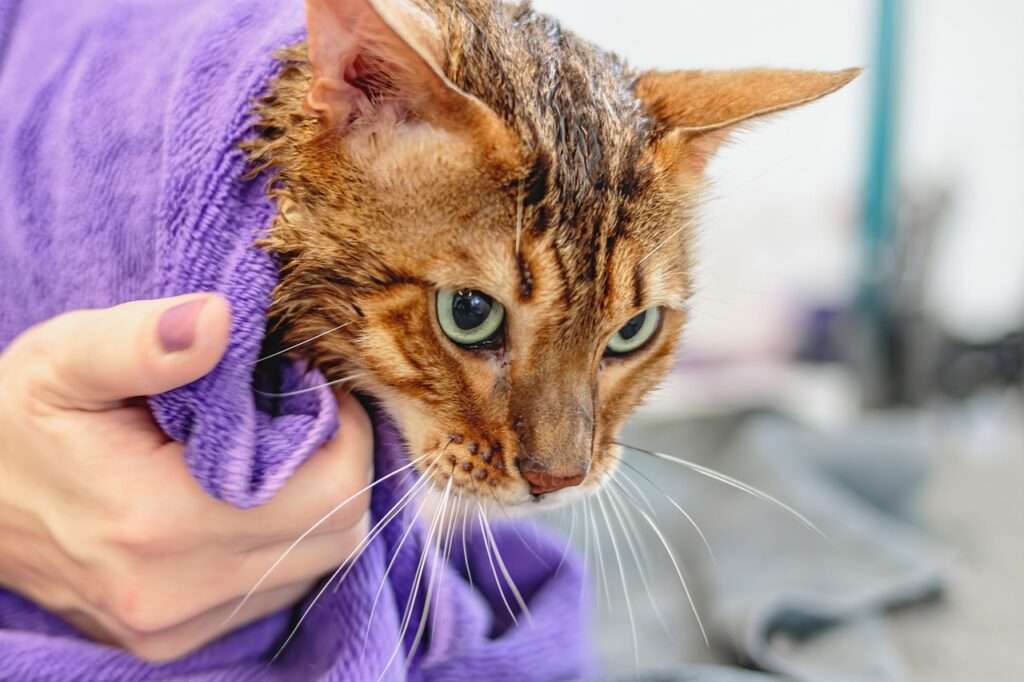The Ultimate Guide: How to Bathe a Cat That Hates Water and Make Them Love It!
As cat owners, we understand that grooming our feline friends is an essential part of their overall well-being. However, one challenge many cat owners face is bathing a cat that despises water. The mere mention of the word “bath” can send these furballs into a frenzy, resulting in scratched arms and a soaked bathroom.
But fear not! In this comprehensive guide, we will delve into the depths of the feline psyche and uncover tried-and-true methods to make bath time a breeze, even for the most water-averse kitties.
Understanding Your Cat’s Fear of Water
Cats are known for their impeccable grooming habits, using their tongues to meticulously clean themselves. This innate self-cleaning behavior stems from their wild ancestors, who relied on their natural oils to protect their fur from the elements. The instinctual aversion to water arises from their evolutionary need to stay dry and maintain insulation.
For some cats, traumatic past experiences may contribute to their fear of water. These experiences can range from accidental sprays with water bottles to being caught in heavy rainstorms. The memory of these incidents can leave a lasting impression on our feline friends, associating water with fear and discomfort. Recognizing and addressing these past traumas is crucial for rebuilding trust and creating positive associations with bathing.
Lastly, cats are known for their sensitivity to temperature and tactile sensations. Water that is too hot or too cold can be uncomfortable and distressing for them. Additionally, the sensation of being wet can feel foreign and unpleasant to some cats. Taking these sensitivities into account, we can adjust our bathing approach to ensure their comfort throughout the process.
Preparing for a Successful Bathing Experience
Choosing the Right Bathing Supplies
Selecting the appropriate bathing supplies is crucial for ensuring a smooth and comfortable experience for your cat. Opt for a cat-friendly shampoo that is specifically formulated for feline needs. These shampoos are designed to be gentle on their sensitive skin and avoid causing any irritation.
Additionally, gather a non-slip mat or towel to provide stability during the bath, a soft-bristled brush for pre-bath grooming, towels or drying materials for post-bath care, and if needed, protective gear such as gloves or a long-sleeved shirt to safeguard yourself from scratches.
Creating a Calm and Safe Environment
To set the stage for a successful bath, it’s essential to choose a quiet and warm room where your cat feels secure. Close doors and windows to minimize outside distractions that may add to their anxiety.
Blocking potential escape routes, such as gaps under doors or openings in cabinets, ensures that your feline friend remains within reach throughout the bathing process. Additionally, consider using pheromone sprays or calming aids designed specifically for cats to help create a serene atmosphere and reduce their stress levels.
Gradual Desensitization and Positive Associations
Help your cat overcome their fear of water by introducing them to it gradually. Start by placing a small bowl of water in their vicinity during playtime or mealtime. This allows them to explore and become accustomed to the presence of water in a non-threatening manner.
Gradually increase their exposure to water by moistening a soft cloth and gently stroking their fur, associating the sensation with positive experiences like treats or gentle praise. This gradual desensitization process helps build trust and positive associations with water, laying the groundwork for a successful bathing experience.
Techniques for Bathing a Reluctant Cat

Dry Bathing Alternatives
For cats that simply cannot tolerate being submerged in water, dry bathing alternatives can be an effective solution. Waterless shampoos and wipes specifically designed for cats provide a convenient option to freshen their coat without the need for a full-blown bath.
Additionally, brushing and combing techniques can help remove dirt and debris from their fur, providing a grooming alternative that doesn’t involve water. In some cases, dry powder baths can also be utilized to keep your cat clean and fresh between traditional baths.
The Towel Method
The towel method offers a gentle and gradual approach to bathing your cat, particularly for those who are water-averse. Start by preparing a towel and a basin of warm water. Begin by wrapping your cat snugly in the towel, exposing only the area you intend to wash.
Use a damp cloth or sponge to wet and clean that specific area, then gently pat dry with the towel. This method allows for a targeted cleaning while minimizing your cat’s exposure to water, reducing their stress levels during the process.
The Sink Method
For cats who may tolerate partial immersion, the sink method can be a viable option. Start by preparing the sink with warm water filled to a comfortable level. Place a non-slip mat or towel at the bottom of the sink to provide stability for your cat.
Using a calm and gentle approach, gradually introduce your cat to the water by allowing them to explore the sink on their terms. Use a small cup or jug to pour water over their body, taking care to avoid their face and ears. Maintain a soothing and reassuring tone throughout the process to keep them calm and comfortable.
The Shower or Tub Method
In cases where your cat is more receptive to a full bath, the shower or tub method can be employed. Prepare the shower or tub area by placing a non-slip mat on the floor to prevent accidents. Acclimate your cat to the bathing area by allowing them to explore the space beforehand, making it a familiar environment.
When it’s time for the bath, gently guide your cat into the shower or tub, using a handheld showerhead or a pitcher to wet their fur with warm water. Apply the cat-friendly shampoo, taking care to avoid their face and ears. Thoroughly rinse their fur with warm water, ensuring all the shampoo is removed. Throughout the process, maintain a calm and soothing demeanor, providing gentle reassurance to your feline friend.
How to Bathe an Aggressive Cat

Recognizing Signs of Aggression and Stress
When dealing with an aggressive cat during bath time, it’s essential to be aware of the warning signs. Aggression can manifest in various ways, such as hissing, growling, swatting, or biting. Additionally, stress-related behaviors like flattened ears, dilated pupils, or a tense body posture can indicate discomfort. It’s crucial to recognize these signs early on to ensure the safety of both you and your cat.
Safety Precautions for Handling Aggressive Cats
Handling an aggressive cat requires caution and the implementation of safety precautions. Consider using protective gear such as thick gloves or a long-sleeved shirt to shield yourself from scratches. Utilize handling tools like a towel or blanket to safely restrain your cat during the bathing process, ensuring minimal harm to both of you. Always prioritize your safety and seek professional assistance if you feel overwhelmed or unable to handle your cat’s aggression effectively.
Alternative Methods for Bathing Aggressive Cats
For cats displaying severe aggression during bath time, alternative methods may be necessary. Consult with your veterinarian or a professional groomer who specializes in working with aggressive cats. They can offer guidance on sedation or medication options to help calm your cat during bathing.
In some cases, gradual desensitization techniques under professional guidance can aid in reducing your cat’s aversion to water over time. Remember, the well-being of your cat is of utmost importance, and seeking professional assistance ensures their safety and comfort.
Post-Bathing Care and Tips

Drying Your Cat Effectively and Safely
After the bath, proper drying is essential to prevent discomfort and potential health issues. Use a soft, absorbent towel to gently dry your cat’s fur, taking care not to rub too vigorously. If your cat is comfortable with it, you can also use a blow dryer on the lowest heat setting, keeping it at a safe distance to avoid overheating or scaring your cat. Ensure that your cat is completely dry before allowing them to go about their day to prevent them from catching a chill.
Rewarding and Comforting Your Cat After the Bath
Once the bath is complete, it’s essential to reward and comfort your cat to reinforce positive associations with the experience. Offer verbal praise in a calm and soothing tone, along with gentle petting and cuddles. Additionally, provide treats or their favorite toys as a special reward for their cooperation during bath time. By showering them with love and positivity, you’re promoting a sense of trust and making the post-bathing experience enjoyable for your cat.
Establishing a Regular Grooming Routine
To maintain your cat’s overall hygiene and well-being, it’s crucial to establish a regular grooming routine. Brushing and combing your cat’s fur on a routine basis helps prevent matting and removes dirt or debris. Additionally, keeping their skin and coat healthy through regular grooming reduces the need for frequent baths.
Schedule professional grooming sessions as needed to maintain their fur in optimal condition. By incorporating grooming into your cat’s routine, you’ll make bath time less daunting, as their coat will require less frequent cleaning.
Conclusion
In conclusion, learning how to bathe a cat that hates water may seem like a daunting task, but with the right knowledge and approach, it can become a manageable and even enjoyable experience. By understanding their instinctual aversion to water, addressing negative past experiences, and considering their sensitivity to temperature and sensation, you can approach bathing in a way that respects your cat’s natural tendencies.
Preparing for a successful bathing experience involves choosing the right supplies, creating a calm and safe environment, and gradually desensitizing your cat to water through positive associations. Techniques such as dry bathing alternatives, the towel method, the sink method, and the shower or tub method provide options for different cats and their unique preferences.
For cats displaying aggression during bath time, recognizing the signs, implementing safety precautions, and seeking professional assistance are paramount. The well-being of both you and your cat should always be prioritized, and alternative methods such as sedation or gradual desensitization under professional guidance can be considered.
After the bath, proper drying, rewarding, and comforting your cat are crucial to reinforce positive associations. Establishing a regular grooming routine that includes brushing and combing helps maintain their overall hygiene and reduces the need for frequent baths.
So, armed with the knowledge and tips from this comprehensive guide, embark on the adventure of transforming bath time into a positive and stress-free experience. Your cat may never become a water enthusiast, but with love, patience, and a little creativity, you can make bath time a breeze and ensure your feline friend stays clean, healthy, and happy.
Frequently Asked Questions
Q: How often should I bathe my cat?
A: Cats are generally self-grooming animals and do not require frequent baths. In most cases, a bath every 4-6 weeks is sufficient. However, certain circumstances may warrant more frequent baths, such as medical conditions or if your cat gets excessively dirty or smelly. Consult with your veterinarian for specific guidance based on your cat’s needs.
Q: What if my cat absolutely refuses to be bathed?
A: If your cat shows extreme aversion to water and is unwilling to be bathed, you can explore alternative grooming options. Dry bathing products, such as waterless shampoos or wipes, can help keep your cat clean between baths. Regular brushing and combing can also remove dirt and debris from their fur. If necessary, consult a professional groomer or veterinarian for advice tailored to your cat’s individual needs.
Q: Can I use human shampoo on my cat?
A: No, it is not recommended to use human shampoo on cats. Human shampoos are formulated for a different pH balance, and the ingredients can be too harsh for a cat’s sensitive skin. Always use a cat-specific shampoo that is mild, gentle, and designed specifically for their needs.
Q: How can I keep my cat calm during bath time?
A: Creating a calm environment is key to reducing stress during bath time. Choose a quiet room, close doors and windows to minimize distractions, and use calming aids like pheromone sprays. Additionally, maintaining a soothing and reassuring tone of voice, offering treats, and providing gentle petting can help keep your cat calm throughout the bathing process.
Q: How do I wash a cat that hates water?
A: Start by using a cat-friendly waterless shampoo or wipes. Gently introduce your cat to water gradually, using a shallow container. Ensure a calm environment and reward your cat with treats for cooperation. If needed, consult your veterinarian for additional tips.
Q: What should I do if my cat becomes aggressive during a bath?
A: Safety should always be your top priority. If your cat becomes aggressive, it’s important to protect yourself and avoid escalating the situation. Stop the bath immediately and consider seeking professional help from a veterinarian or groomer experienced in handling aggressive cats. They can provide guidance on handling techniques, sedation options, or alternative grooming methods.
Q: How can I dry my cat if they are afraid of blow dryers?
A: If your cat is fearful of blow dryers, opt for towel drying instead. Use a soft towel to gently pat and absorb the excess moisture from their fur. If necessary, place them in a warm and draft-free room to air dry naturally. Avoid forcing your cat to tolerate something that causes them distress and adapt your drying method accordingly.
Remember, every cat is unique, and it’s important to tailor your approach to their individual needs and preferences. If you have specific concerns or questions regarding bathing your cat, consult with your veterinarian or a professional groomer who can provide personalized advice and guidance.





